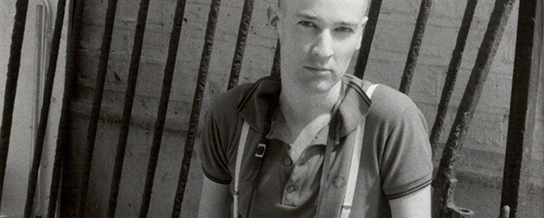Paul Hartnett’s Creatures of the Night
Paul Hartnett’s first photographs depict starfish, donkeys on the beach and other scenes from the […]

Paul Hartnett’s Creatures of the Night
Paul Hartnett’s first photographs depict starfish, donkeys on the beach and other scenes from the […]

Paul Hartnett’s first photographs depict starfish, donkeys on the beach and other scenes from the British seaside resort at Clacton. Subsequent flicks were a sight more tawdry. As a teen, Hartnett rebelled against his Catholic school upbringing and became obsessed with the glittering denizens of the London underground. His career path was altered when, at the age of 18, he photographed punk icon Soo Catwoman at a London club called Bang Disco. What ensued was 30 years of documenting the dramatic highs and seedy lows of youth culture, particularly in queer clubs like Taboo and Naïve, a drag king party he started in 1995. We caught up with Hartnett at his home in an old brewery in Haworth, West Yorkshire, and talked to him about style, substance, and why the internet is shit.
XLR8R: Have you ever taken a photo that you felt couldn’t be shown because the emotional content in it was too embarrassing, painful or disturbing?
Paul Hartnett: I tend not to take photographs that are in any way manipulative or exploitative. When I have, for example, photographed someone who has been drunk or drug-fucked, I will often edit these out of a presentation as they can be demeaning. I do not do nudes. Sometimes I have photographed dancers who look so lost, and these images tend not to get published as I feel a camera can be invasive and that is not my intention. I feel very protective about my subjects.
Does your style change when using different cameras or are the cameras just a means to an end?
I keep everything basic. I like to see lots of “information.” I love clarity. For me it’s all about the face, and details… the stitch of a hem, customizing, adornment.
If you could travel back in time to any era in history, which would you choose?
As a collector of Victorian and Edwardian photographs (check out the “Vintage” section of paulhartnett.com), I would have loved to photograph Oscar Wilde and his crew of dandies, or Quentin Crisp at the time of his arrest, when he was a sex worker in Piccadilly.
Who is your style icon?
I do not tend to have a style icon who is a major name, but I tend to adore a muse from time to time. The musician NIYI is a fascination. The artists Pascal Herren (of Fanklub in Antwerp) and Matthew Stone in London are amazing people–so articulate, so fastidious. Not lazy thinkers!
How much influence did your upbringing have on what you decided to do later?
The Benedictine monks who taught me (so little educationally or spiritually) were a massive motivating force for so many years. The school I attended certainly failed the duty of care. This worked out in my favor once I self-repaired the internal damage. Maybe that’s why I photograph the people I do.
When did it dawn on you that you could be a photographer for a living?
When I was 18. It was the time of punk, and there I was with a camera. It beat working in a cafe, although I think a towel around my waist would have been quite a look.
What do you think was the most resonant look of the ’80s?
Big bad hair, big bad make-up… suiting the bad manners.
What’s the best advice you’ve ever received?
“Ouch, that hurt. Slow down!”
How is club culture different now than inthe ’70s and ’80s?
I feel that MySpace, YouTube and the internet in general is actually killing creativity. I wish Osama bin Laden would blow up the Internet!
Does fashion have to have meaning to be interesting or important?
Fashion and style should not be lazy. It’s all a code. Nowadays there are too many H&M zombies out there.
In your mind, what constitutes a great party?
A great looker, a great dancer, magic in the air. These things cannot be bought.
Who is your favorite photographer?
Probably a forensic photographer, or some random guy with a studio in Turkey or Tunisia… or a photobooth. Really.
Is there one piece, or artist’s body of work, that changed the way you viewed what art could be?
At school I used to stare at the walls when the teachers talked. We had a lot of Matisse about, and Renoir.
Where is your favorite public place to be in London?
Hyde Park, feeding grapes to the crows. The section near the Peter Pan statue is good for that.

